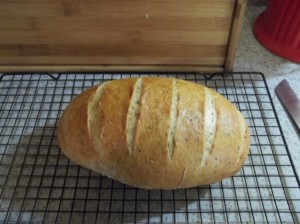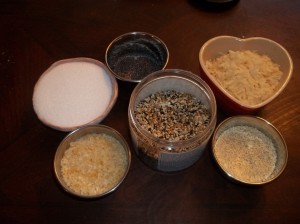Baking is chemistry and biology and math all rolled up into one and it produces yummy things to eat. What more could a nerdy girl want?

Sourdough is wonderful stuff. It seems sort of magical to me. You take water and flour and stick them together. And then you add more water and flour. And more water and flour and before you know it, you’ve got this stuff that will make bread rise. This is fascinating to me. But, then, so is most of baking.
When I decided to do sourdough, I looked at about a million and a half ways to make a starter. Some of them had half a dozen or more ingredients to get started and they seemed like they were just a little too fussy. The simplest ones had just two ingredients (flour and water) and a couple had just three or, at most, four. I ended up using a hybrid of a couple different starter methods.
Before I go into what I did and why, I’m going to give a quick rundown on why sourdough actually works.
Most yeast-risen breads use some sort of commercial, storebought yeast. It comes in little packets or jars (or if you’re like me in one-or-two-pound bricks), it’s pretty inexpensive, and it’s generally foolproof if you pay attention to the dates on the container. Sourdough, on the other hand, relies on wee beasties that are living naturally on flour and in the air. They’re just about everywhere and they just need a little care and feeding before you can harness them to do your bidding.
Continue reading Sourdough: The Starter That Ate the Fridge




